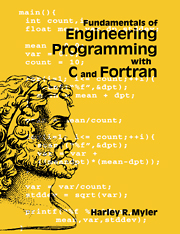Book contents
- Frontmatter
- Contents
- Preface
- 1 Introduction
- 2 Computer Programming
- 3 Types, Operators, and Expressions
- 4 Control Flow
- 5 Type Conversion, Functions, and Scope
- 6 Pointers, Arrays, and Structures
- 7 File Operations
- 8 Case Studies
- Appendix A C Language Summary
- Appendix B Fortran Program Language Summary
- Appendix C ASCII Tables
- Appendix D C Preprocessor Directives
- Appendix E Precedence Tables
- Glossary
- Annotated Bibliography
- Index
Preface
Published online by Cambridge University Press: 05 June 2012
- Frontmatter
- Contents
- Preface
- 1 Introduction
- 2 Computer Programming
- 3 Types, Operators, and Expressions
- 4 Control Flow
- 5 Type Conversion, Functions, and Scope
- 6 Pointers, Arrays, and Structures
- 7 File Operations
- 8 Case Studies
- Appendix A C Language Summary
- Appendix B Fortran Program Language Summary
- Appendix C ASCII Tables
- Appendix D C Preprocessor Directives
- Appendix E Precedence Tables
- Glossary
- Annotated Bibliography
- Index
Summary
This text is intended as an entry-level treatment of engineering problem-solving and programming using C and Fortran, the predominant computer languages of engineering. Although C is presented as the language of choice for program development, a reading knowledge of Fortran (77) is emphasized. The text assumes that any Fortran code encountered by the reader is operational and debugged; hence, an emphasis is placed on a reading knowledge of this language. Fundamental approaches to engineering problem-solving using the computer are developed, and appendixes that serve as ready reference for both languages are included. A basic premise of this book is that the engineer, regardless of discipline, is more interested in fast program prototyping and accurate data outputs than in program elegance or structure. The novice engineering programmer is concerned principally with modeling physical systems or phenomena and processing accurate data pertaining to those systems or phenomena. These are basic tenets of engineering programming that are subscribed to in this book.
In the introductory chapter, an understanding of basic computer architecture using the von Neumann model is developed as a register–ALU–memory (Arithmetic Logic Unit) transfer system. This concept is then integrated into an explanation of Tannenbaum's virtual machine hierarchy to illustrate the multiple levels of translation and interpretation that exist in modern computers. The relationship of programming languages to this hierarchy is then explained through diagrams and illustrations to enable the reader to develop a strong mental picture of computer function through language.
Information
- Type
- Chapter
- Information
- Fundamentals of Engineering Programming with C and Fortran , pp. xi - xivPublisher: Cambridge University PressPrint publication year: 1998
